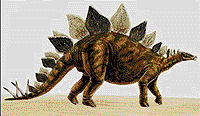 | Dinosaur Noses on the Move |
 | Dinosaur Noses on the Move |
|
August 13, 2001
Although the bony nasal opening is preserved in dinosaur fossils, the fleshy nostril is not. The bony nasal opening is often much larger than the nostril and most artists have drawn the nostrils far back along the bony opening. In a paper published in Science (August 3, 2001), Witmer explains why this is not the correct location. He studied the positions of both the fleshy nostrils and bony nasal openings in modern birds, lizards and crocodiles. In every animal he studied, the fleshy nostril was located far toward the front of the bony nasal opening. Witmer also studied small grooves in dinosaur skulls. These grooves were made by blood vessels that supplied nasal tissue and were similar to those in other animals he studied. This suggests that the dinosaur's nostrils were located in a place similar to that in other animals: at the end of the snout.
Witmer traces the incorrect placement of the nostrils to the discovery of the large sauropod dinosaur called Diplodocus. Early paleontologists believed that Diplodocus lived in the water and that the large nasal opening, apparently located toward the back of the snout, served as a snorkel to help the animal breathe. However, close observation shows that the bony nasal opening extends far forward, allowing the possibility that nostrils were further toward the front. In addition researchers now believe that Diplodocus lived on land, not in the water. Nevertheless, artists continued to draw the nostril toward the back of the snout as in previous depictions, not only in Diplodocus, but when illustrating other dinosaurs as well. A nostril in a more forward position seems more efficient than a nostril toward the back of the snout. The sense of smell is important for animals finding food, locating mates, detecting predators and identifying territory. Nostrils at the end of the snout allow reptiles and other animals to smell objects directly in front of them. |
Did you know? | A stegosaurus weighed approximately 1,600 kg but had a brain that weighed only 70 grams (0.07 kg). Therefore, its brain was only 0.004% of its total body weight. In contrast, an adult human weighs approximately 70 kg and has a brain that weighs 1.4 kg making the human brain about 2% of the total body weight. These calculations show that the brain to body ratio of the human 500 times greater than that of the stegosaurus. |
|
Reference and further information:
|
| GO TO: | Neuroscience In The News | Explore the Nervous System | Table of Contents |
![[email]](./gif/menue.gif) Send E-mail |
 Fill out survey |
 Get Newsletter |
 Search Pages |
 Take Notes |